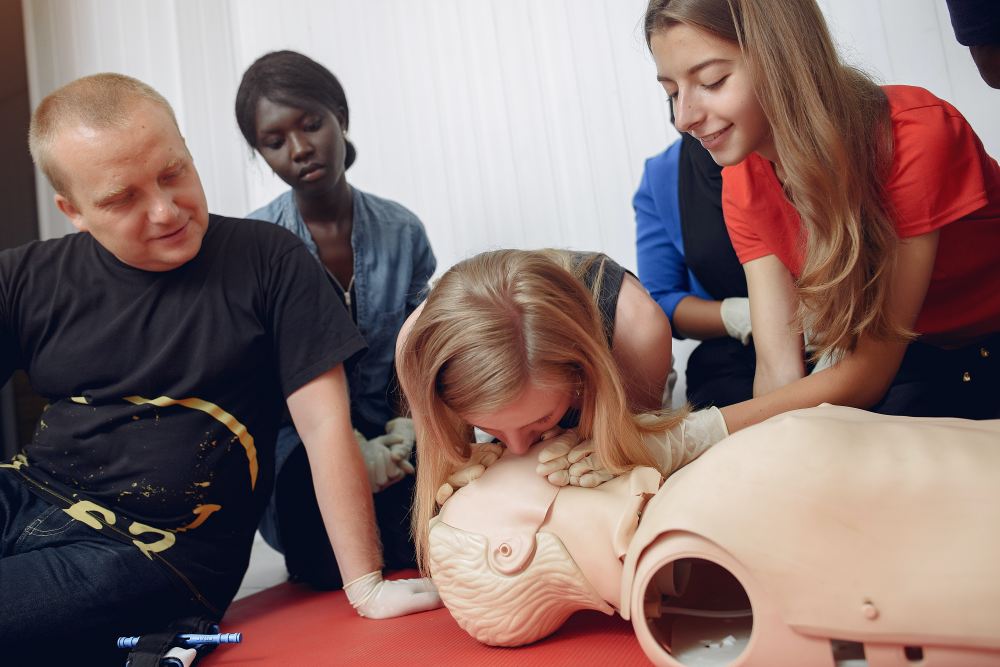Održavanje prohodnosti dišnih putova odnosi se na kontinuirane napore i tehnike koje se primjenjuju kako bi se osiguralo da dišni put osobe ostane čist i otvoren, omogućavajući učinkovito disanje. To je ključno u različitim zdravstvenim postavkama, posebno tijekom hitnih situacija kada je sposobnost pojedinca da diše ugrožena.
Postoji nekoliko metoda koje se mogu koristiti za održavanje prohodnosti dišnih putova, uključujući:
- Pozicioniranje: Ispravno pozicioniranje glave i vrata temeljno je. To uključuje tehnike poput nagiba glave i podizanja brade ili manevra potiskivanja donje čeljusti prema naprijed i prema gore, što može pomoći usklađivanju dišnog puta i otvaranju istog.
- Aspiracija: u slučajevima opstrukcije dišnih putova zbog sekreta, krvi ili drugih tekućina, koristi se isisavanje kako bi se uklonile takve prepreke i osigurao prohodan dišni put.
- Pomagala za dišne putove: razni uređaji mogu se koristiti za održavanje prohodnosti dišnih putova. Oraofaringealni ili nazofaringealni tubusi česti su pomagala za zbrinjavanje dišnog puta koji pomažu spriječiti da jezik blokira dišni put i omogućuju učinkovitiji protok zraka.
- Terapija kisikom: administracija kisika putem različitih metoda, poput nazalnih katetera, maski ili mehaničke ventilacije, pomaže osigurati dovoljnu opskrbu kisikom plućima i krvotoku pacijenta.
- Intubacija: endotrahealna intubacija je postupak kojim se cijev umeće u dušnik kako bi se osigurao dišni put. Ovo se obično izvodi u ozbiljnijim slučajevima ili tijekom kirurških zahvata.
- Pomlaaga za dišne putove iznad glasnica: ti uređaji, poput laringealne maske (LMA), pružaju siguran i privremeni dišni put pacijentima koji trebaju ventilaciju ili su u opasnosti od kompromitacije dišnih putova.
- Krikotireotomija: U ekstremnim slučajevima kada sve druge metode zakažu, izvodi se krikotireotomija kojom se izrađuje umjetni dišni put.
Konkretna metoda koja se odabire za održavanje prohodnosti dišnih putova ovisi o stanju pacijenta, dostupnoj opremi i stručnosti zdravstvenog radnika. Brza i odgovarajuća reakcija ključna je kako bi se osiguralo da pacijent i dalje prima adekvatnu opskrbu kisikom i može učinkovito disati.
Zrak prolazi kroz otvorene i čiste dišne puteve tijekom normalnog disanja u tišini i bez napora. Ako osoba može odgovarati normalnim glasom bez pratećih zvukova, možemo zaključiti da su joj dišni putevi otvoreni i prohodni. Znakovi koji ukazuju na kompromitirane dišne puteve uključuju zvukove hrkanja (djelomična opstrukcija zbog pada jezika unatrag, prisutnost stranog tijela, edem) ili klokotanje/gurkanje (prisutnost tekućeg sadržaja koji zahtijeva aspiraciju), promuklost, stridor pri udahu (inspiratorni stridor), hropce pri izdisaju (ekspiratorni hropci), napor pri disanju i moguće kašljanje. U takvim slučajevima, svjesni pacijenti mogu se žaliti na osjećaj gušenja i izgledati vidljivo uznemireni. U slučaju potpune opstrukcije dišnih putova, zrak više ne može prolaziti, a osoba ne može disati, govoriti ili kašljati. Može doći do paradoksalnog kretanja prsnog koša i trbuha, poput “kolutanja”, pri čemu prsa idu prema unutra, a trbuh se širi tijekom pokušaja udaha, i obrnuto tijekom pokušaja izdaha.
Mogući uzroci kompromitiranih dišnih putova uključuju:
- Povlačenje jezika i mekih tkiva prema natrag zbog promijenjene svijesti
- Krv
- Sadržaji želuca zbog povraćanja ili regurgitacije
- Strana tijela (npr. hrana, zubne proteze)
- Oteklina zbog infekcije, anafilaksije ili opeklina
- Bronhalni sekreti koje osoba ne može iskašljati sama
- Ozljeda
- Laringospazam i bronhospazam
- Opstrukcija traheostomije
Prvi zadatak u skrbi za hitne pacijente je uspostavljanje otvorenih i čistih dišnih putova, što se može postići jednostavnim postupcima poput nagiba glave i podizanja brade, potiska donje čeljusti prema naprijed i prema gore, aspiracije sadržaja dišnih putova (npr. povraćaj ili krv) i postavljanja pomoćnih uređaja za dišne puteve poput orofaringealnih ili nazofaringealnih cijevi. Takvi pacijenti vjerojatno će zahtijevati primjenu kisika s ciljanim vrijednostima zasićenosti arterijske krvi kisikom od 94-98% (u uvjetima sklonim hiperkapniji, poput KOPB-a, ciljane vrijednosti su 88-92%, a kod akutnog infarkta miokarda s elevacijom ST segmenta, nadopuna kisikom razmatra se samo ako zasićenost arterijske krvi kisikom padne ispod 90%). Ovi postupci ne osiguravaju potpuno prohodne dišne putove, a za postizanje potpune prohodnosti koristimo endotrahealnu intubaciju ili uređaje za dišne putove iznad glasnica.
Endotrahealna intubacija je zlatni standard za zaštitu dišnih putova jer se kad se manžeta endotrahealne cijevi napuše, djeluje kao barijera koja sprječava ulazak stranih tvari u dišne puteve, kao što su sekreti iz gornjih dišnih putova, krv, regurgitirani sadržaj probavnog sustava ili drugi strani predmeti. Međutim, endotrahealna intubacija nije uvijek moguća, posebno u prehospitalnim postavkama. U slučajevima kada su sve prethodne metode za zaštitu dišnih putova zatajile, može biti potrebna krikotireotomija.
MJERE OSOBNE ZAŠTITE: Kao i kod svih medicinskih postupaka, osobna zaštita je neophodna. Prilikom izvođenja postupaka uspostavljanja dišnih putova, obavezno je koristiti zaštitne rukavice, masku i zaštitne naočale. Nosimo zaštitnu opremu kako bismo spriječili kontakt kože i zaštitili oči i dišne puteve od krvi ili drugih tjelesnih tekućina pacijenta te tako izbjegli prijenos zaraznih bolesti.

